NUR3101: Evaluating Australia's Immunization Strategy in Primary Care
VerifiedAdded on 2022/10/04
|6
|1447
|20
Report
AI Summary
This report analyzes Australia's primary healthcare strategy, focusing on the issue of poor immunization rates, particularly in rural areas. It examines the epidemiological factors contributing to this issue, such as lack of awareness, poor socio-economic backgrounds, and limited access to healthcare services. The report highlights the social determinants of health, including equity and social justice, emphasizing how these factors influence immunization rates. The analysis is framed within the context of the Australian primary healthcare strategic framework, specifically the strategy to "improve access and reduce inequity." The report also discusses the five key principles of Primary Healthcare (PHC) as defined by the WHO and their relevance to addressing immunization challenges. Potential actions to improve immunization rates are suggested, including supporting health system models, encouraging multidisciplinary teams, and exploring funding models to incentivize improved outcomes. The study concludes by emphasizing the crucial role of primary health care services in solving national healthcare issues and improving health outcomes for all individuals, regardless of their background.
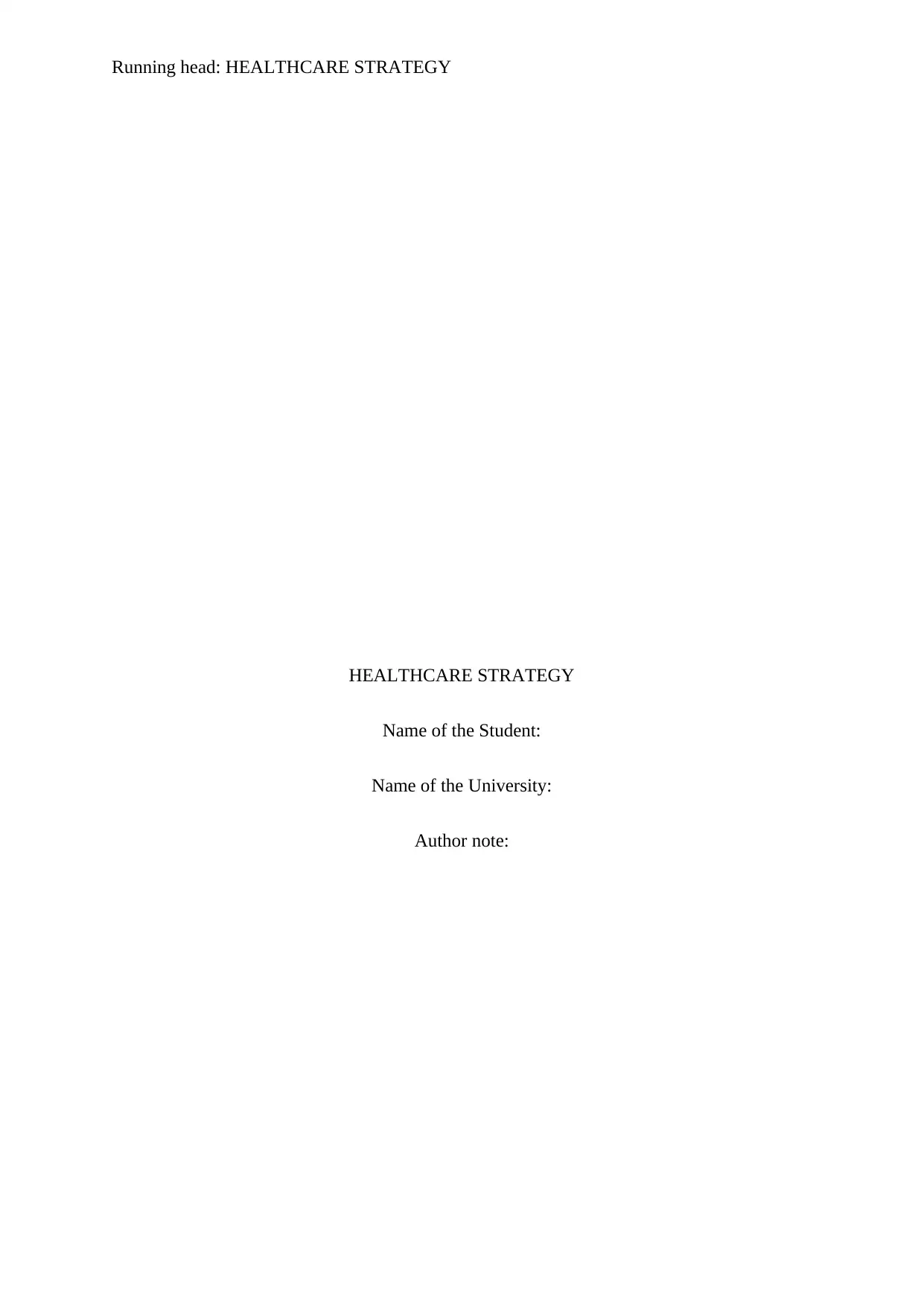
Running head: HEALTHCARE STRATEGY
HEALTHCARE STRATEGY
Name of the Student:
Name of the University:
Author note:
HEALTHCARE STRATEGY
Name of the Student:
Name of the University:
Author note:
Paraphrase This Document
Need a fresh take? Get an instant paraphrase of this document with our AI Paraphraser
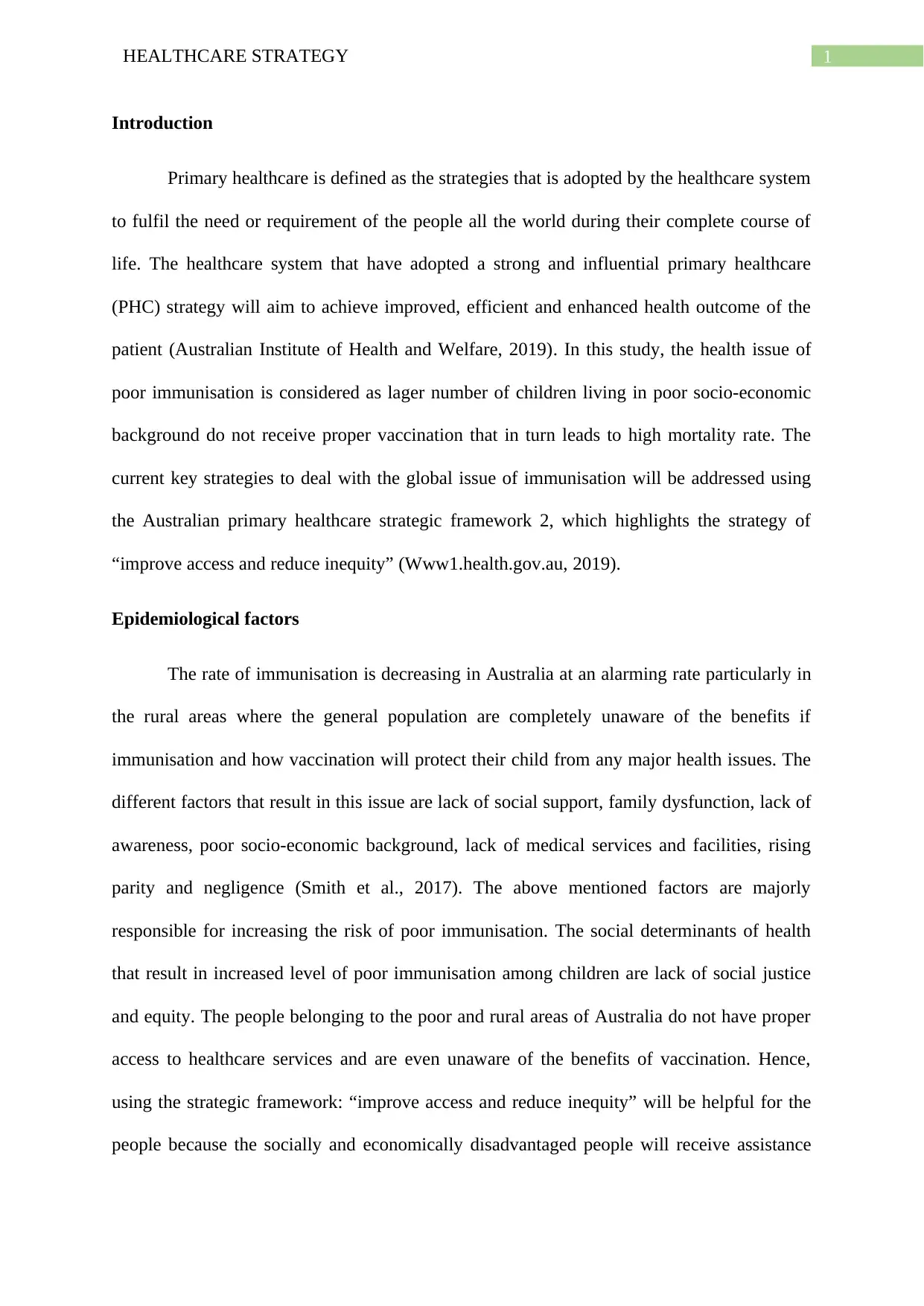
1HEALTHCARE STRATEGY
Introduction
Primary healthcare is defined as the strategies that is adopted by the healthcare system
to fulfil the need or requirement of the people all the world during their complete course of
life. The healthcare system that have adopted a strong and influential primary healthcare
(PHC) strategy will aim to achieve improved, efficient and enhanced health outcome of the
patient (Australian Institute of Health and Welfare, 2019). In this study, the health issue of
poor immunisation is considered as lager number of children living in poor socio-economic
background do not receive proper vaccination that in turn leads to high mortality rate. The
current key strategies to deal with the global issue of immunisation will be addressed using
the Australian primary healthcare strategic framework 2, which highlights the strategy of
“improve access and reduce inequity” (Www1.health.gov.au, 2019).
Epidemiological factors
The rate of immunisation is decreasing in Australia at an alarming rate particularly in
the rural areas where the general population are completely unaware of the benefits if
immunisation and how vaccination will protect their child from any major health issues. The
different factors that result in this issue are lack of social support, family dysfunction, lack of
awareness, poor socio-economic background, lack of medical services and facilities, rising
parity and negligence (Smith et al., 2017). The above mentioned factors are majorly
responsible for increasing the risk of poor immunisation. The social determinants of health
that result in increased level of poor immunisation among children are lack of social justice
and equity. The people belonging to the poor and rural areas of Australia do not have proper
access to healthcare services and are even unaware of the benefits of vaccination. Hence,
using the strategic framework: “improve access and reduce inequity” will be helpful for the
people because the socially and economically disadvantaged people will receive assistance
Introduction
Primary healthcare is defined as the strategies that is adopted by the healthcare system
to fulfil the need or requirement of the people all the world during their complete course of
life. The healthcare system that have adopted a strong and influential primary healthcare
(PHC) strategy will aim to achieve improved, efficient and enhanced health outcome of the
patient (Australian Institute of Health and Welfare, 2019). In this study, the health issue of
poor immunisation is considered as lager number of children living in poor socio-economic
background do not receive proper vaccination that in turn leads to high mortality rate. The
current key strategies to deal with the global issue of immunisation will be addressed using
the Australian primary healthcare strategic framework 2, which highlights the strategy of
“improve access and reduce inequity” (Www1.health.gov.au, 2019).
Epidemiological factors
The rate of immunisation is decreasing in Australia at an alarming rate particularly in
the rural areas where the general population are completely unaware of the benefits if
immunisation and how vaccination will protect their child from any major health issues. The
different factors that result in this issue are lack of social support, family dysfunction, lack of
awareness, poor socio-economic background, lack of medical services and facilities, rising
parity and negligence (Smith et al., 2017). The above mentioned factors are majorly
responsible for increasing the risk of poor immunisation. The social determinants of health
that result in increased level of poor immunisation among children are lack of social justice
and equity. The people belonging to the poor and rural areas of Australia do not have proper
access to healthcare services and are even unaware of the benefits of vaccination. Hence,
using the strategic framework: “improve access and reduce inequity” will be helpful for the
people because the socially and economically disadvantaged people will receive assistance
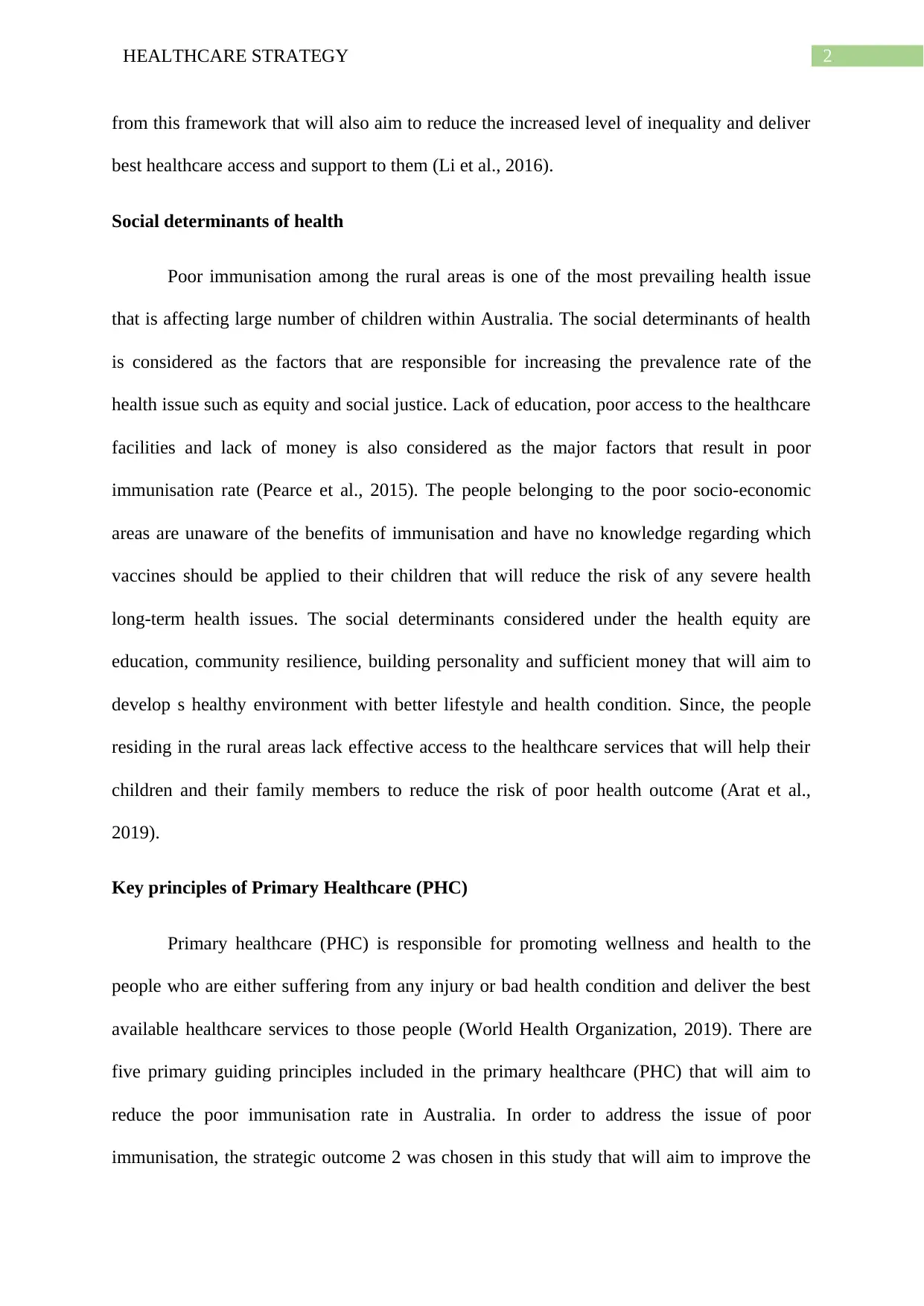
2HEALTHCARE STRATEGY
from this framework that will also aim to reduce the increased level of inequality and deliver
best healthcare access and support to them (Li et al., 2016).
Social determinants of health
Poor immunisation among the rural areas is one of the most prevailing health issue
that is affecting large number of children within Australia. The social determinants of health
is considered as the factors that are responsible for increasing the prevalence rate of the
health issue such as equity and social justice. Lack of education, poor access to the healthcare
facilities and lack of money is also considered as the major factors that result in poor
immunisation rate (Pearce et al., 2015). The people belonging to the poor socio-economic
areas are unaware of the benefits of immunisation and have no knowledge regarding which
vaccines should be applied to their children that will reduce the risk of any severe health
long-term health issues. The social determinants considered under the health equity are
education, community resilience, building personality and sufficient money that will aim to
develop s healthy environment with better lifestyle and health condition. Since, the people
residing in the rural areas lack effective access to the healthcare services that will help their
children and their family members to reduce the risk of poor health outcome (Arat et al.,
2019).
Key principles of Primary Healthcare (PHC)
Primary healthcare (PHC) is responsible for promoting wellness and health to the
people who are either suffering from any injury or bad health condition and deliver the best
available healthcare services to those people (World Health Organization, 2019). There are
five primary guiding principles included in the primary healthcare (PHC) that will aim to
reduce the poor immunisation rate in Australia. In order to address the issue of poor
immunisation, the strategic outcome 2 was chosen in this study that will aim to improve the
from this framework that will also aim to reduce the increased level of inequality and deliver
best healthcare access and support to them (Li et al., 2016).
Social determinants of health
Poor immunisation among the rural areas is one of the most prevailing health issue
that is affecting large number of children within Australia. The social determinants of health
is considered as the factors that are responsible for increasing the prevalence rate of the
health issue such as equity and social justice. Lack of education, poor access to the healthcare
facilities and lack of money is also considered as the major factors that result in poor
immunisation rate (Pearce et al., 2015). The people belonging to the poor socio-economic
areas are unaware of the benefits of immunisation and have no knowledge regarding which
vaccines should be applied to their children that will reduce the risk of any severe health
long-term health issues. The social determinants considered under the health equity are
education, community resilience, building personality and sufficient money that will aim to
develop s healthy environment with better lifestyle and health condition. Since, the people
residing in the rural areas lack effective access to the healthcare services that will help their
children and their family members to reduce the risk of poor health outcome (Arat et al.,
2019).
Key principles of Primary Healthcare (PHC)
Primary healthcare (PHC) is responsible for promoting wellness and health to the
people who are either suffering from any injury or bad health condition and deliver the best
available healthcare services to those people (World Health Organization, 2019). There are
five primary guiding principles included in the primary healthcare (PHC) that will aim to
reduce the poor immunisation rate in Australia. In order to address the issue of poor
immunisation, the strategic outcome 2 was chosen in this study that will aim to improve the
⊘ This is a preview!⊘
Do you want full access?
Subscribe today to unlock all pages.

Trusted by 1+ million students worldwide
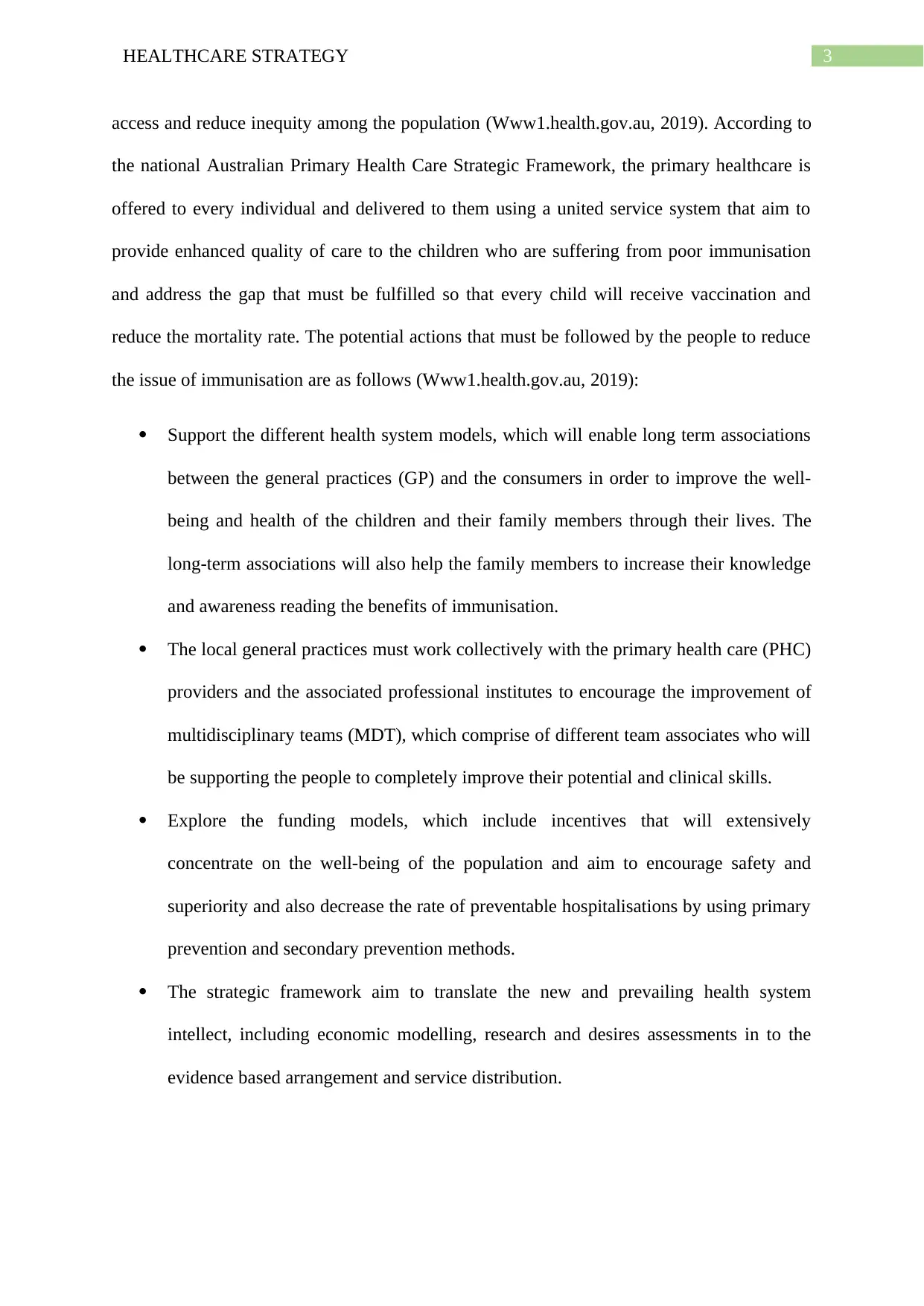
3HEALTHCARE STRATEGY
access and reduce inequity among the population (Www1.health.gov.au, 2019). According to
the national Australian Primary Health Care Strategic Framework, the primary healthcare is
offered to every individual and delivered to them using a united service system that aim to
provide enhanced quality of care to the children who are suffering from poor immunisation
and address the gap that must be fulfilled so that every child will receive vaccination and
reduce the mortality rate. The potential actions that must be followed by the people to reduce
the issue of immunisation are as follows (Www1.health.gov.au, 2019):
Support the different health system models, which will enable long term associations
between the general practices (GP) and the consumers in order to improve the well-
being and health of the children and their family members through their lives. The
long-term associations will also help the family members to increase their knowledge
and awareness reading the benefits of immunisation.
The local general practices must work collectively with the primary health care (PHC)
providers and the associated professional institutes to encourage the improvement of
multidisciplinary teams (MDT), which comprise of different team associates who will
be supporting the people to completely improve their potential and clinical skills.
Explore the funding models, which include incentives that will extensively
concentrate on the well-being of the population and aim to encourage safety and
superiority and also decrease the rate of preventable hospitalisations by using primary
prevention and secondary prevention methods.
The strategic framework aim to translate the new and prevailing health system
intellect, including economic modelling, research and desires assessments in to the
evidence based arrangement and service distribution.
access and reduce inequity among the population (Www1.health.gov.au, 2019). According to
the national Australian Primary Health Care Strategic Framework, the primary healthcare is
offered to every individual and delivered to them using a united service system that aim to
provide enhanced quality of care to the children who are suffering from poor immunisation
and address the gap that must be fulfilled so that every child will receive vaccination and
reduce the mortality rate. The potential actions that must be followed by the people to reduce
the issue of immunisation are as follows (Www1.health.gov.au, 2019):
Support the different health system models, which will enable long term associations
between the general practices (GP) and the consumers in order to improve the well-
being and health of the children and their family members through their lives. The
long-term associations will also help the family members to increase their knowledge
and awareness reading the benefits of immunisation.
The local general practices must work collectively with the primary health care (PHC)
providers and the associated professional institutes to encourage the improvement of
multidisciplinary teams (MDT), which comprise of different team associates who will
be supporting the people to completely improve their potential and clinical skills.
Explore the funding models, which include incentives that will extensively
concentrate on the well-being of the population and aim to encourage safety and
superiority and also decrease the rate of preventable hospitalisations by using primary
prevention and secondary prevention methods.
The strategic framework aim to translate the new and prevailing health system
intellect, including economic modelling, research and desires assessments in to the
evidence based arrangement and service distribution.
Paraphrase This Document
Need a fresh take? Get an instant paraphrase of this document with our AI Paraphraser
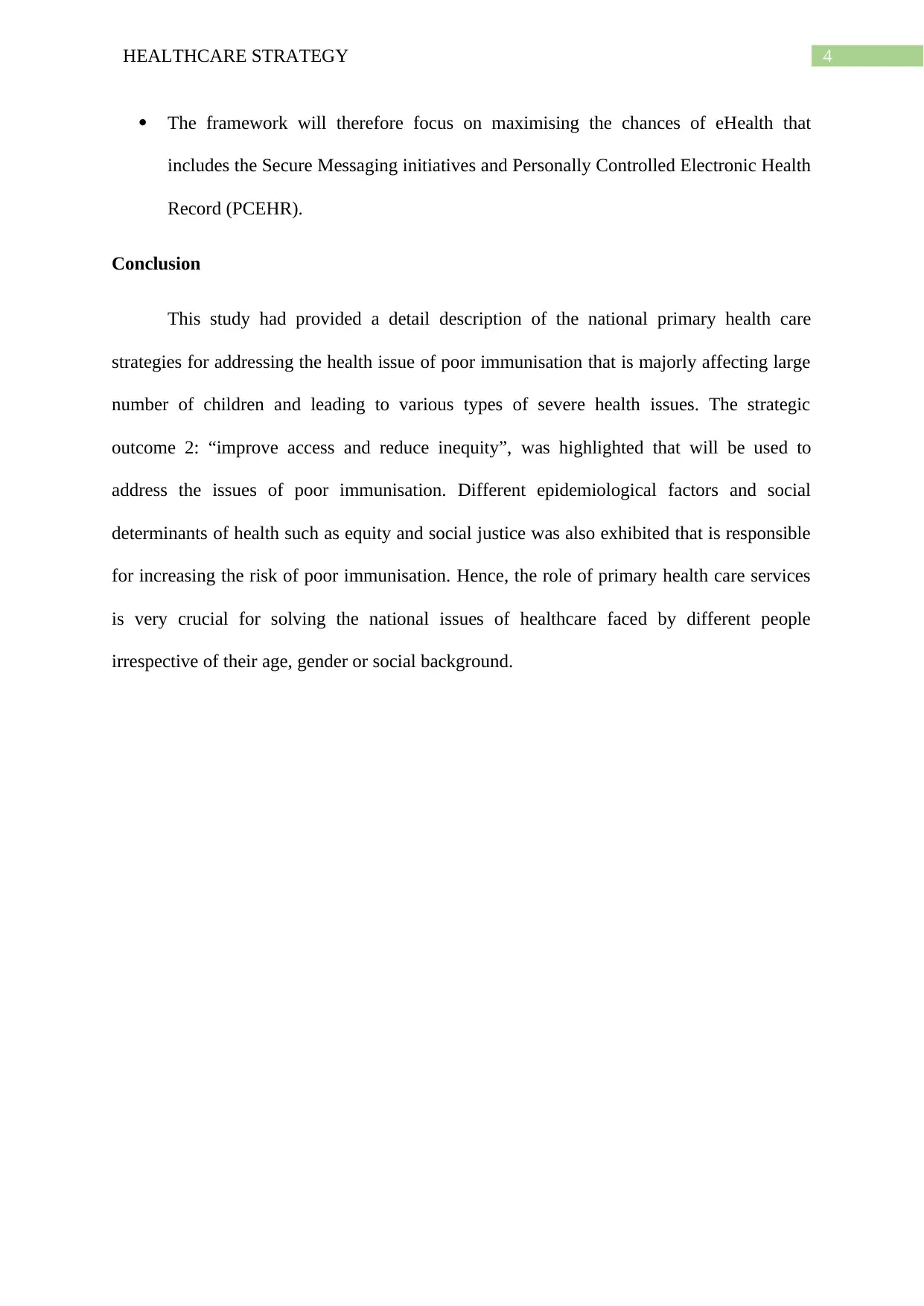
4HEALTHCARE STRATEGY
The framework will therefore focus on maximising the chances of eHealth that
includes the Secure Messaging initiatives and Personally Controlled Electronic Health
Record (PCEHR).
Conclusion
This study had provided a detail description of the national primary health care
strategies for addressing the health issue of poor immunisation that is majorly affecting large
number of children and leading to various types of severe health issues. The strategic
outcome 2: “improve access and reduce inequity”, was highlighted that will be used to
address the issues of poor immunisation. Different epidemiological factors and social
determinants of health such as equity and social justice was also exhibited that is responsible
for increasing the risk of poor immunisation. Hence, the role of primary health care services
is very crucial for solving the national issues of healthcare faced by different people
irrespective of their age, gender or social background.
The framework will therefore focus on maximising the chances of eHealth that
includes the Secure Messaging initiatives and Personally Controlled Electronic Health
Record (PCEHR).
Conclusion
This study had provided a detail description of the national primary health care
strategies for addressing the health issue of poor immunisation that is majorly affecting large
number of children and leading to various types of severe health issues. The strategic
outcome 2: “improve access and reduce inequity”, was highlighted that will be used to
address the issues of poor immunisation. Different epidemiological factors and social
determinants of health such as equity and social justice was also exhibited that is responsible
for increasing the risk of poor immunisation. Hence, the role of primary health care services
is very crucial for solving the national issues of healthcare faced by different people
irrespective of their age, gender or social background.
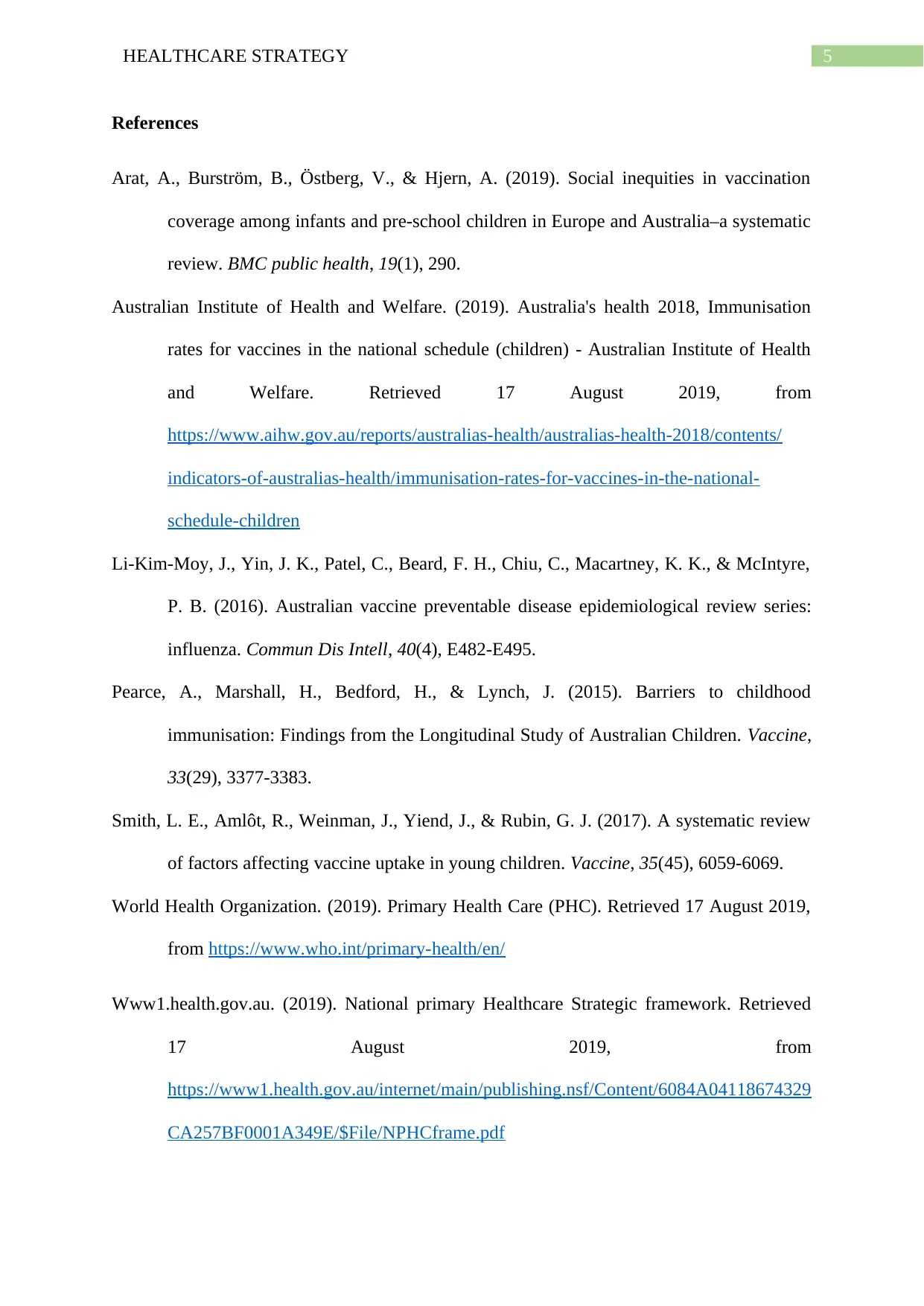
5HEALTHCARE STRATEGY
References
Arat, A., Burström, B., Östberg, V., & Hjern, A. (2019). Social inequities in vaccination
coverage among infants and pre-school children in Europe and Australia–a systematic
review. BMC public health, 19(1), 290.
Australian Institute of Health and Welfare. (2019). Australia's health 2018, Immunisation
rates for vaccines in the national schedule (children) - Australian Institute of Health
and Welfare. Retrieved 17 August 2019, from
https://www.aihw.gov.au/reports/australias-health/australias-health-2018/contents/
indicators-of-australias-health/immunisation-rates-for-vaccines-in-the-national-
schedule-children
Li-Kim-Moy, J., Yin, J. K., Patel, C., Beard, F. H., Chiu, C., Macartney, K. K., & McIntyre,
P. B. (2016). Australian vaccine preventable disease epidemiological review series:
influenza. Commun Dis Intell, 40(4), E482-E495.
Pearce, A., Marshall, H., Bedford, H., & Lynch, J. (2015). Barriers to childhood
immunisation: Findings from the Longitudinal Study of Australian Children. Vaccine,
33(29), 3377-3383.
Smith, L. E., Amlôt, R., Weinman, J., Yiend, J., & Rubin, G. J. (2017). A systematic review
of factors affecting vaccine uptake in young children. Vaccine, 35(45), 6059-6069.
World Health Organization. (2019). Primary Health Care (PHC). Retrieved 17 August 2019,
from https://www.who.int/primary-health/en/
Www1.health.gov.au. (2019). National primary Healthcare Strategic framework. Retrieved
17 August 2019, from
https://www1.health.gov.au/internet/main/publishing.nsf/Content/6084A04118674329
CA257BF0001A349E/$File/NPHCframe.pdf
References
Arat, A., Burström, B., Östberg, V., & Hjern, A. (2019). Social inequities in vaccination
coverage among infants and pre-school children in Europe and Australia–a systematic
review. BMC public health, 19(1), 290.
Australian Institute of Health and Welfare. (2019). Australia's health 2018, Immunisation
rates for vaccines in the national schedule (children) - Australian Institute of Health
and Welfare. Retrieved 17 August 2019, from
https://www.aihw.gov.au/reports/australias-health/australias-health-2018/contents/
indicators-of-australias-health/immunisation-rates-for-vaccines-in-the-national-
schedule-children
Li-Kim-Moy, J., Yin, J. K., Patel, C., Beard, F. H., Chiu, C., Macartney, K. K., & McIntyre,
P. B. (2016). Australian vaccine preventable disease epidemiological review series:
influenza. Commun Dis Intell, 40(4), E482-E495.
Pearce, A., Marshall, H., Bedford, H., & Lynch, J. (2015). Barriers to childhood
immunisation: Findings from the Longitudinal Study of Australian Children. Vaccine,
33(29), 3377-3383.
Smith, L. E., Amlôt, R., Weinman, J., Yiend, J., & Rubin, G. J. (2017). A systematic review
of factors affecting vaccine uptake in young children. Vaccine, 35(45), 6059-6069.
World Health Organization. (2019). Primary Health Care (PHC). Retrieved 17 August 2019,
from https://www.who.int/primary-health/en/
Www1.health.gov.au. (2019). National primary Healthcare Strategic framework. Retrieved
17 August 2019, from
https://www1.health.gov.au/internet/main/publishing.nsf/Content/6084A04118674329
CA257BF0001A349E/$File/NPHCframe.pdf
⊘ This is a preview!⊘
Do you want full access?
Subscribe today to unlock all pages.

Trusted by 1+ million students worldwide
1 out of 6
Related Documents
Your All-in-One AI-Powered Toolkit for Academic Success.
+13062052269
info@desklib.com
Available 24*7 on WhatsApp / Email
![[object Object]](/_next/static/media/star-bottom.7253800d.svg)
Unlock your academic potential
Copyright © 2020–2025 A2Z Services. All Rights Reserved. Developed and managed by ZUCOL.





